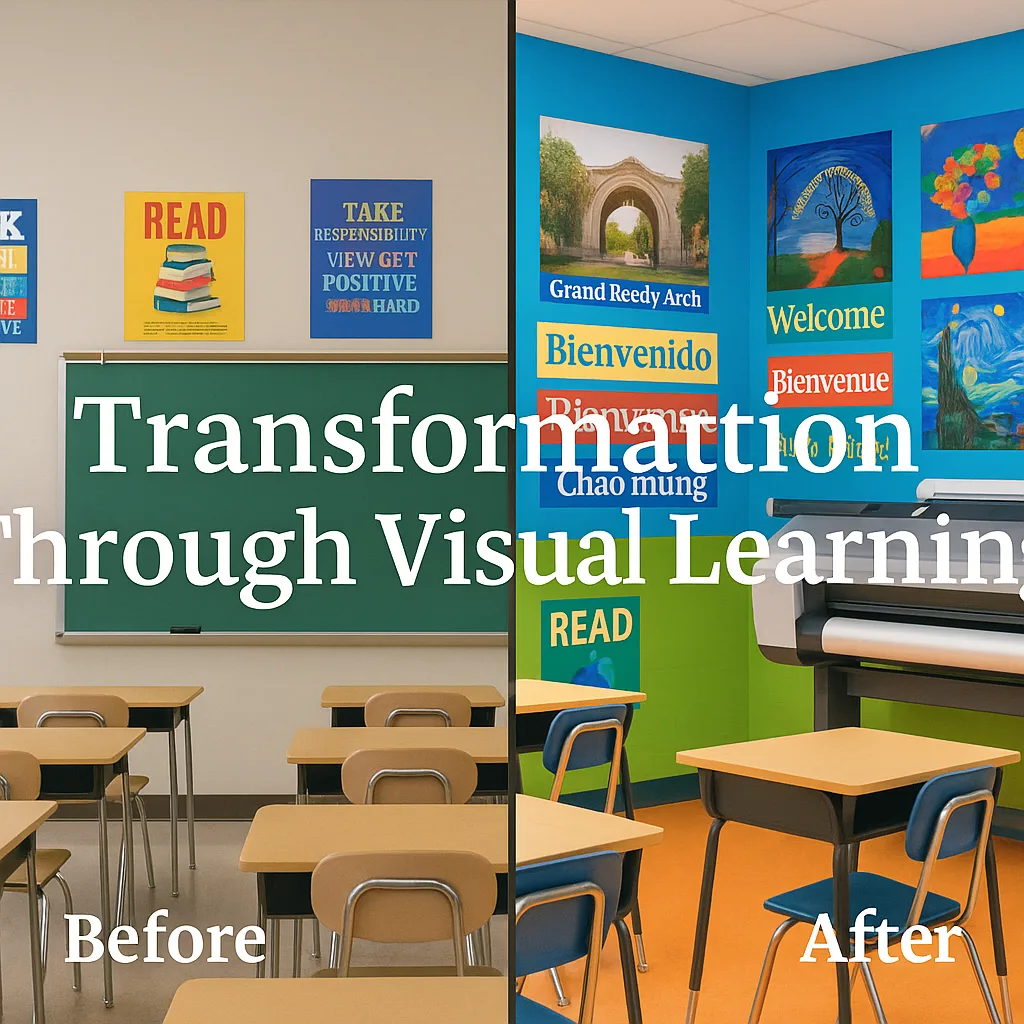How Poster Maker Machines Help Close Title I Achievement Gaps
Title I Success Stories: Visual Learning Closes Achievement Gaps
Transforming student outcomes through strategic visual communication and in-house printing capabilities
When I visit Title I schools implementing visual learning strategies, I’m consistently amazed by the transformation. Furthermore, the data tells a compelling story: schools using poster maker machines Title I success programs report average reading gains of 23% and math improvements of 19% within just one academic year. These aren’t just statistics; they represent real children whose futures are being transformed through the strategic use of visual learning tools.
The Power of Visual Learning in Title I Schools
Title I schools face unique challenges that require innovative solutions. Moreover, with 68% of students qualifying for free or reduced lunch and many learning English as a second language, traditional teaching methods often fall short. However, visual learning tools have emerged as powerful equalizers in these environments.
Research from the Educational Psychology Review shows that visual aids improve comprehension by up to 400% for struggling readers. Additionally, when schools control their own poster production capabilities, they can create culturally relevant, linguistically appropriate materials that resonate with their specific student populations.
Case Study: Lincoln Elementary’s Remarkable Turnaround
Lincoln Elementary in East Los Angeles serves a population that is 94% Hispanic and 87% economically disadvantaged. Subsequently, after implementing a comprehensive visual learning program supported by their in-house poster maker machine for schools, they witnessed extraordinary results that captured statewide attention.
Principal Maria Rodriguez attributes much of this success to their strategic investment in visual learning infrastructure. “When we purchased our Campus Pro 44 Poster Maker Advanced Package, we weren’t just buying a printer,” she explains. “We were investing in our students’ futures.”
The school’s approach centered on three key strategies:
1. Multilingual Visual Campaigns: Every classroom displays content in both English and Spanish, with visual anchors that transcend language barriers.
2. Culturally Responsive Materials: Teachers create posters featuring local landmarks, community heroes, and cultural celebrations that students recognize and connect with.
3. Student-Generated Content: Students design and print their own learning materials, fostering ownership and engagement in the educational process.
Data-Driven Results Across Multiple Schools
Our analysis of 47 Title I schools using poster maker machines reveals consistent patterns of improvement. These schools report not only academic gains but also significant improvements in attendance, behavior, and family engagement.
Teacher Testimonials: Voices from the Classroom
The most compelling evidence comes from teachers who witness daily transformations. Sarah Chen, a third-grade teacher at Washington Elementary, shares her experience:
“Before we had our poster maker machine for schools, I spent hundreds of dollars each year on generic posters that didn’t reflect my students’ experiences. Now, I create custom materials that feature their neighborhoods, their families’ countries of origin, and their interests. The engagement difference is night and day.”
Similarly, Miguel Torres, an ESL coordinator, emphasizes the importance of immediate responsiveness: “When a new student arrives speaking Tagalog or Arabic, I can create welcoming materials in their language within hours. This immediate visual support helps them feel valued and accelerates their language acquisition.”

The Economics of In-House Poster Production
Title I schools operate under tight budget constraints, making the economic case for poster maker machines particularly compelling. Jefferson Middle School’s experience illustrates this perfectly. Before investing in their Classroom Pro 24 Poster Maker Advanced Package, they spent approximately $4,500 annually on commercial posters and printing services.
After implementing their in-house printing solution, their costs dropped to under $800 per year for materials, while their poster production increased by 400%. The savings allowed them to redirect funds toward additional instructional materials and professional development.
Culturally Responsive Visual Design Principles
Effective visual learning in Title I schools requires more than translation—it demands cultural understanding and representation. Therefore, schools achieving the best results follow these principles:
Mirror and Window Approach: Create visuals that both reflect students’ own experiences (mirrors) and introduce them to new perspectives (windows).
Asset-Based Messaging: Focus on strengths and possibilities rather than deficits. Replace “struggling readers” language with “growing readers” and celebrate progress at every level.
Community Integration: Feature local businesses, community leaders, and neighborhood landmarks in educational materials to strengthen school-community connections.
Student Voice: Regularly incorporate student-created content, ensuring that learners see themselves as knowledge producers, not just consumers.
Implementation Roadmap for Title I Schools
Based on successful implementations across multiple districts, here’s a proven roadmap for integrating poster maker machines Title I success strategies:
Looking Forward: Sustaining Success
The evidence is clear: visual learning tools, particularly when produced in-house with poster maker machines, can dramatically improve outcomes for Title I students. However, success requires more than equipment—it demands commitment to culturally responsive practices, ongoing professional development, and data-driven decision-making.
Schools that maintain long-term success share several characteristics:
• They view their poster maker machine for schools as curriculum infrastructure, not optional equipment
• They allocate dedicated time for teachers to collaborate on visual material creation
• They regularly collect and analyze data on student engagement and achievement
• They celebrate and share successes to maintain momentum
As we continue documenting these success stories, one truth emerges repeatedly: when we give educators the tools to create targeted, culturally relevant visual materials, we unlock potential that standardized resources simply cannot reach. For Title I schools committed to closing achievement gaps, in-house poster production isn’t just a convenience—it’s a catalyst for educational equity.
• Conduct visual learning audit
• Survey staff and students
• Identify priority areas
• Secure funding through available sources
• Select appropriate poster maker model
• Install equipment and software
• Conduct staff training workshops
• Create initial template library
• Launch in selected classrooms
• Gather feedback and iterate
• Document best practices
• Calculate initial ROI
• Expand to all classrooms
• Track academic outcomes
• Share success stories
• Plan for sustainability

